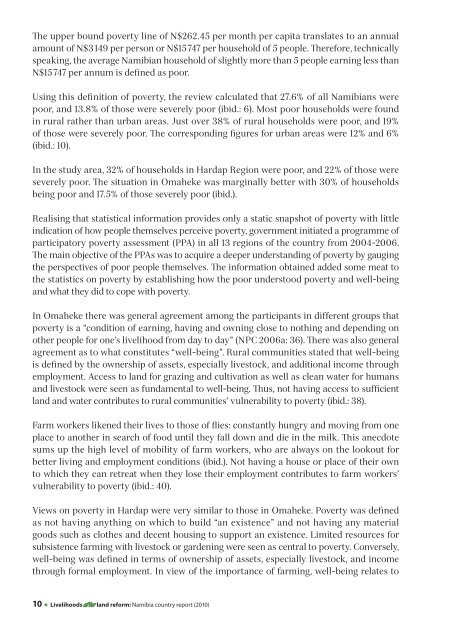Namibia country report
Namibia country report
Namibia country report
- No tags were found...
You also want an ePaper? Increase the reach of your titles
YUMPU automatically turns print PDFs into web optimized ePapers that Google loves.
The upper bound poverty line of N$262.45 per month per capita translates to an annualamount of N$3 149 per person or N$15 747 per household of 5 people. Therefore, technicallyspeaking, the average <strong>Namibia</strong>n household of slightly more than 5 people earning less thanN$15 747 per annum is defined as poor.Using this definition of poverty, the review calculated that 27.6% of all <strong>Namibia</strong>ns werepoor, and 13.8% of those were severely poor (ibid.: 6). Most poor households were foundin rural rather than urban areas. Just over 38% of rural households were poor, and 19%of those were severely poor. The corresponding figures for urban areas were 12% and 6%(ibid.: 10).In the study area, 32% of households in Hardap Region were poor, and 22% of those wereseverely poor. The situation in Omaheke was marginally better with 30% of householdsbeing poor and 17.5% of those severely poor (ibid.).Realising that statistical information provides only a static snapshot of poverty with littleindication of how people themselves perceive poverty, government initiated a programme ofparticipatory poverty assessment (PPA) in all 13 regions of the <strong>country</strong> from 2004-2006.The main objective of the PPAs was to acquire a deeper understanding of poverty by gaugingthe perspectives of poor people themselves. The information obtained added some meat tothe statistics on poverty by establishing how the poor understood poverty and well-beingand what they did to cope with poverty.In Omaheke there was general agreement among the participants in different groups thatpoverty is a “condition of earning, having and owning close to nothing and depending onother people for one’s livelihood from day to day” (NPC 2006a: 36). There was also generalagreement as to what constitutes “well-being”. Rural communities stated that well-beingis defined by the ownership of assets, especially livestock, and additional income throughemployment. Access to land for grazing and cultivation as well as clean water for humansand livestock were seen as fundamental to well-being. Thus, not having access to sufficientland and water contributes to rural communities’ vulnerability to poverty (ibid.: 38).Farm workers likened their lives to those of flies: constantly hungry and moving from oneplace to another in search of food until they fall down and die in the milk. This anecdotesums up the high level of mobility of farm workers, who are always on the lookout forbetter living and employment conditions (ibid.). Not having a house or place of their ownto which they can retreat when they lose their employment contributes to farm workers’vulnerability to poverty (ibid.: 40).Views on poverty in Hardap were very similar to those in Omaheke. Poverty was definedas not having anything on which to build “an existence” and not having any materialgoods such as clothes and decent housing to support an existence. Limited resources forsubsistence farming with livestock or gardening were seen as central to poverty. Conversely,well-being was defined in terms of ownership of assets, especially livestock, and incomethrough formal employment. In view of the importance of farming, well-being relates to10 ● Livelihoods after land reform: <strong>Namibia</strong> <strong>country</strong> <strong>report</strong> (2010)
















